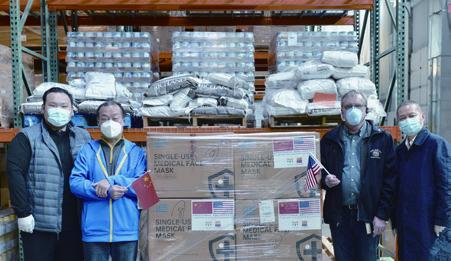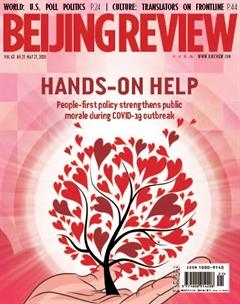Facts vs.Fabrications
By Wang Zhuolun

By May 14, confi rmed cases of the novel coronavirus disease (COVID-19) in the United States had crossed 1.39 million, with the death toll surpassing 84,000.
However, instead of concentrating on fighting the pandemic domestically, some U.S. politicians have been fabricating allegations to pin the blame on China and hide their irresponsibility.
But the facts speak for themselves.
Origin of COVID-19
Did COVID-19 originate in Wuhan in Central China? Not necessarily. The place that first reports a virus may not be its place of origin. Increasing evidence proves that the Spanish fl u did not originate in Spain.
The origin of COVID-19 has still not been identifi ed. Source tracing is a serious scientifi c matter, which should be based on science and be done by scientists and medical experts. Calling the virus “Wuhan virus” or “China virus”is stigmatization.
On February 11, the World Health Organization (WHO) officially named the pneumonia caused by the novel coronavirus COVID-19. It was done on the basis of its 2015 Best Practices for the Naming of New Human Infectious Diseases, which clearly stipulates that the naming of a disease should not be associated with a particular country or place.
There is also abundant evidence showing that cases occurred outside China earlier than deemed. USA Today reported on May 6 that 171 people in Florida showed symptoms of COVID-19 as early as in January, and none reported traveling to China.
Michael Melham, Mayor of Belleville in New Jersey, said he tested positive for coronavirus antibodies, and may have been sick with the virus back in November last year—over two months before the first reported case in the United States on January 20.
Mainstream Western media, including The New York Times, ABC and BBC, all have reported how the wrongful connection of Asian communities with COVID-19 stoked serious xenophobia and frequent discrimination and harassment of these communities in the United States.
WHO and scientists worldwide have fi ercely rebutted the allegation made by some U.S. politicians that the virus was constructed and leaked by the Wuhan Institute of Virology.
WHO spokesperson Fadela Chaib stressed on April 21 that all available evidence suggested the virus has an animal origin and is“not manipulated or constructed in a lab or somewhere else.” Chaib also said it most likely has its ecological reservoir in bats but how it was transmitted from bats to humans is still to be discovered.
British medical journal The Lancet said in a report published on February 19 that COVID-19 originated in wildlife, as have so many other emerging pathogens.
Anthony Fauci, Director of the U.S. National Institute of Allergy and Infectious Diseases, told National Geographic in an interview published on May 4, “If you look at the evolution of the virus in bats and whats out there now, [the scientifi c evidence] is very, very strongly leaning toward this could not have been artifi cially or deliberately manipulated.”
The timeline
China has provided timely information on the virus in an open, transparent and responsible manner.
On December 27, 2019, three cases of pneumonia of unknown cause were immediately reported by Zhang Jixian, a doctor in Wuhan, after she received the patients. It was the first reporting of suspected cases of a new disease by the local authorities. On the same day, epidemiological investigation and tests on the patients were conducted by the Wuhan Center for Disease Control and Prevention.
The next few days witnessed two emergency notices and a situation report by the Wuhan authorities. On December 31, 2019, China informed the WHO China Country Offi ce of the cases of pneumonia of unknown cause and from January 3, began sending regular, timely updates about the novel coronavirus to WHO and different countries, including the United States.
China completed the identification and sequencing of the virus as early as on January 7 and shared the genome sequence information with WHO and different countries on January 11.
Nine days later, the National Health Commission informed the media that the novel coronavirus could be transmitted from person to person. On January 22, WHO issued a warning about the potential risk of human-to-human transmission on its website, and eight days later, it declared the outbreak a public health emergency of international concern.
Chinas transparency in data releasing has been consistent. On April 17, Wuhan issued a notification revising up confi rmed cases by 325 to a total of 50,333, and fatal cases by 1,290 to a total of 3,869.
Revision doesnt mean covering up. On the contrary, it was out of a high sense of responsibility to the people and to the lives lost to the coronavirus that Wuhan took the initiative. When the city was fi rst hit by the virus, the hospitals were overloaded and some patients passed away at home. These deaths were missed, in addition to delayed, inadequate or inaccurate reporting of cases.
On April 28, Christoffer Koch and Ken Okamura, two economists from the United States and the United Kingdom, respectively, jointly published a paper based on studies of the data from China, Italy and the United States. They said the confirmed infections in China are similar to those in the other two countries and there was no possibility of manipulation of fi gures.

Hollow export claims
The comprehensive and rigorous measures taken by the Chinese Government within the shortest possible time limited the number of infections to more than 700,000 fewer than expected in the absence of intervention measures and the chain of transmissions was broken domestically.
Wuhan was put under lockdown from January 23 to April 8. So it was impossible for Wuhan residents to travel overseas during this period.
Social distancing measures were strictly observed nationwide, effectively curbing the spread of the virus. Suspected cases and their close contacts were placed under quarantine at designated places to stem further spread of the virus.
Chinas response, demonstrating speed, scale and efficiency, have been rarely seen in the world, WHO Director General Tedros Adhanom Ghebreyesus said, adding that Chinas experience is worth learning for other countries.
This explains why Chinas infection rate stayed relatively low once the measures kicked in. As for the allegations that China spread the virus to the rest of the world, this is what research found outside China.
In the United States, The New York Times cited U.S. research as concluding that most New York coronavirus cases did not come from Asia.
In Canada, data from its major provinces showed that the virus was brought into the country by U.S. visitors.
In France, research found that the virus strain circulating locally was of unknown origin.
In Singapore, cases imported from China were less than one 10th of those from other countries.
In Japan, researchers believed that the strain confirmed in the country since early March was not from China.
In Russia, none of the imported cases was from China.
Manip ulating WHO?
In the middle of the pandemic, the United States decided to halt funding WHO, saying it“failed to adequately obtain, vet and share information in a timely and transparent fashion.”Some U.S. politicians alleged China was manipulating and bribing the organization.

